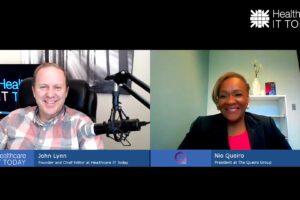The following is a guest article by Gary Meyer, Assistant Vice President at Cognizant.
As they say in the Marvel cinematic universe, what if… What if providers had a current, comprehensive view of their patients’ clinical and administrative health history available at the point of care? What if prior authorization were automated between provider and payers and their systems and processes? What if providers and patients could review treatment options and their costs real-time in making decisions?
Imagine how much more efficient visits would be, as CMS puts it, without patients reciting their “recollections of a prior care episode,” or when data about care from outside a health system is easily accessible.
This scenario isn’t from the multiverse and going from “what if” to reality doesn’t require superpowers. It does, though, call for going beyond mere compliance with federal interoperability, price transparency and no surprises regulations. These latest government regulations are less about what happens within a single institution and more about what can and should happen through new information flows among industry constituents.
Given the nature of these new regulatory mandates, it’s no longer enough to understand the obvious, direct impact on your organization. Beyond that scope of concern, you must understand how others’ regulations create opportunity for your own organization. The interoperability, price transparency and no surprises mandates give you access to others’ data like you’ve never had access before. In our changing world, it’s critical to think broadly about how you can use the data made available by other parties’ mandates to benefit your organization’s mission. It’s time to widen the aperture.
Regulatory reshaping of the healthcare ecosystem
Reviewing two new payer mandates illuminates the impact of this new generation of regulations across the healthcare ecosystem.
In CMS-9115-F, the Interoperability and Patient Access Final Rule, the Department of Health and Human Services “creates and implements new mechanisms to enable patients to access their own health care information through third-party software applications, thereby providing them with the ability to decide how, when, and with whom to share their information.” (https://www.cms.gov/files/document/cms-9115-f.pdf) This access is to be accomplished via the Patient Access Application Programming Interface (API) and its support for HL7® Fast Healthcare Interoperability Resources (FHIR®).
This new rule is already in regulatory effect for payers in Medicare Advantage, managed Medicaid, managed CHIP, and Qualified Health Plans on the Federally Facilitated Exchanges.
Another significant proposed regulation affecting payers is CMS-9123-P, the “Reducing Patient and Provider Burden Proposed Rule.” This rule is anticipated to be finalized soon. It calls for payers to create a Provider Access API, a new mechanism for the technology that providers use daily to get to data that payers have about the patient. (https://www.cms.gov/files/document/121020-reducing-provider-and-patient-burden-cms-9123-p.pdf)
The effect of these combined rules is to give providers the opportunity to access the breadth of the data payers have about patients. It’s information providers may use at the point of care, and specifically includes “adjudicated claims and encounter data (not including cost information), clinical data as defined in the USCDI, and information related to pending and active prior authorization decisions.” (https://www.cms.gov/files/document/121020-reducing-provider-and-patient-burden-cms-9123-p.pdf)
Payer compliance with these regulations effectively creates opportunities for providers to improve their efficiency, patient experience and outcomes, as providers discover how to integrate this new data into existing systems and workflows.
What to do now
Now, providers can take these four steps to take full advantage of the opportunities unleashed by these new standards-based data flows and APIs.
Develop a strategy for monitoring regulations on payers, pharma, etc., and their wider impact.
As proposed payer regulations become final, understand timelines and implications for your specific patient populations. For example, CMS has focused initially on specific government-sponsored health plans. If a provider has a significant Medicare Advantage or Medicaid patient population, it’s critical to start evaluating how to leverage this newly accessible data in practices, operations and analytics. Get the strategic perspective of outside experts who know these regulations and their nuances.
Ask your EMR vendor how it plans to support the proposed Provider Access API as part of their interoperability strategy.
The Provider Access API will enable providers’ EMRs to access the superset of your data plus the data your patient’s insurer holds. Providers should tell vendors they want an integrated, easily accessible view of all of a patient’s conditions, medications, care team, etc., both within and beyond the data sets the health system manages. Ask the vendor how it will integrate the external data of active prior authorizations, price transparency data and advance EOBs into the features and workflows of its product.
Prepare to fill in capability gaps.
Depending upon the EMR vendor’s strategy, it may be useful for some providers to build or buy a third-party tool for looking up patient data that the patient’s payer has. Providers should avoid scenarios in which they are locked into one vendor’s ecosystem. Rapid technology advances mean providers can select best of breed tools built for open platforms. Look for open solutions that can integrate data across external organizations.
Scope a pilot project.
Consider defining and launching a payer data interoperability project with technical, workflow and benefit realization workstreams. In the technical workstream, test how to integrate new real-time external data into your tech stack. In the workflow workstream, determine how to integrate external data into care delivery, front office and back-office processes. Finally, in the benefit realization workstream, evaluate the tangible and intangible benefits of using this additional patient data.
As new regulations pull down the barriers around our industry’s information silos, the tactical “how do we stay compliant?” query must be complemented by the strategic “how do we take advantage of the compliance actions of other industry players?” Organizations with strategies for integrating data that will flow from insurers, researchers, pharma, etc., will be equipped to improve care and deliver better experiences.
In our world, it’s a superpower to get and use data made available through the regulatory mandates placed on one’s trading partners and competitors.
 About Gary Meyer
About Gary Meyer
Gary Meyer is an Assistant Vice President within Cognizant Consulting’s healthcare practice. He brings 25 years of industry experience, having brought innovation to leading health plans, health systems, and others in the industry. Gary leads Cognizant Consulting’s advisory services for healthcare interoperability, helping organizations define and execute their strategies to achieve compliance as well as to better position themselves in their markets through interoperability.













